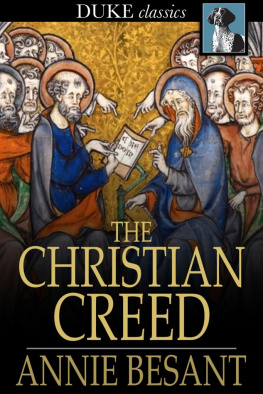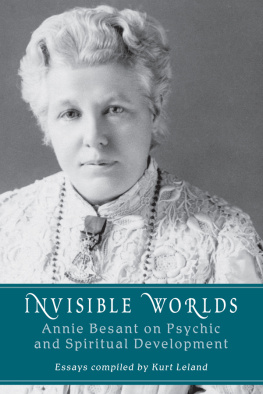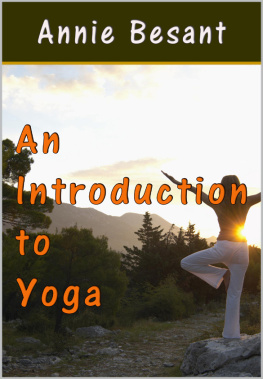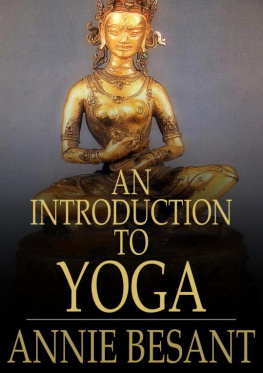EVOLUTION OF LIFE AND FORM
FOUR LECTURES DELIVERED AT THE TWENTY-THIRD ANNIVERSARY MEETING OF THE THEOSOPHICAL SOCIETY AT ADYAR, MADRAS, 1898
* * *
ANNIE BESANT
*
Evolution of Life and Form
Four Lectures Delivered at the Twenty-Third Anniversary Meeting of the Theosophical Society at Adyar, Madras, 1898
First published in 1900
ISBN 978-1-62013-915-8
Duke Classics
2014 Duke Classics and its licensors. All rights reserved.
While every effort has been used to ensure the accuracy and reliability of the information contained in this edition, Duke Classics does not assume liability or responsibility for any errors or omissions in this book. Duke Classics does not accept responsibility for loss suffered as a result of reliance upon the accuracy or currency of information contained in this book.
Contents
*
First Lecture - Ancient and Modern Science
*
My Brothers:The subject on which I am to address you this morning, andthe three mornings that follow, is one of considerable complexity anddifficulty. I do not apologise to you for the difficulty of my theme.When we meet here in our Anniversary Meeting, we meet as students andnot simply as superficial men and women of the world. We try to prepareourselves, by study, for the exchange of thought which in thesegatherings takes place, and although the subject is a difficult one,although it is not possible to make it clear and intelligible withoutthe use of certain technical terms, yet, to the student technicaltermsbeing preciseare really the easiest to understand, and inasmuchas, in a great majority at least, we are students, I who speak, and youwho listen, we may be content to treat the subject in a somewhat formaland technical way. Roughly, my outline is this. I want to lay before youan intelligible conception of evolution, taking it on its two sides,that of the evolving life and that of the developing forms. I begin bylaying before you a sketch of the methods of "Ancient and ModernScience," the direction in which each has worked, and is working, theultimate union that, we hope, may take place between them. For whatcould more fully presage the good of the whole world, what could promisemore happily for the relationship between the different races ofhumanity, than to draw together on the plane of mind the science ofantiquity and of modern days, the science of the East and of the West,and, by wedding them to each other, draw together the nations that arenow divided, and make objective that brotherhood of humanity of which wedream.
Dealing first with ancient and modern science in this broad and generalway, and taking that as my subject for this morning, I shall pass onto-morrow to speak on the "Functions of the Gods," meaning by thatphrase the activities of that invisible side of nature on which thewhole of the visible depends. Whether we use here the name "Devas" torepresent those developed spiritual intelligences, or whether with thechild of Islm, with the Hebrew or the Christian, we speak of the"Angels" and "Archangels," the name matters nothing; the conception iscommon to every faith of man. We shall study their functions in theuniverse, and try to understand how they act as the ministers of theDivine Will. Then we shall pass on to treat of that "Evolution of Life"which lies underneath the evolution of forms. Finally, we shall treatthe "Evolution of Forms," and see how, in that evolution, is the promiseof final perfection, how all is working to a perfect ending, how thebest that we can dream of is less than the performance of God.
That is the outline of our work. Let us at once begin the first sectionof the subjectAncient and Modern Science.
Now, in the olden times, in those times to which in this land ourthought turns back most fondly with reverence and with pride, in thosetimes, here, as in every other ancient land, Religion and Science werewedded together, and there was no discord between the intelligence andthe spirit. It matters not whither you wander amid the ancient nationsof the world: you may travel through the whole of Chaldea; you may studythe remains of ancient Egypt; you may go through Persia and search amidher monuments; you may cross the Atlantic to America, and unbury thecities that were lost ere yet the Aztecs had made the mighty State whichfell under the blows of the Spaniards; you may go into China and, in thevast recesses of that well-nigh unknown land, you may search for whathas been left there from ancient days; or without going outside thelimits of your own land, you may take the literature that is our pride,the mighty books written by the Rishis of the past; and everywhereantiquity speaks with a single tongue. Religion reveals the spirit, thespiritual truth which is one. Intelligence studies that truth in itsmanifold manifestations, and its work; science, studying the phenomenawhich are images of aspects of the Divine, is the handmaid, is thesister, of religion, and between them discord is unnatural and fatal toprogress. That is the ancient view; but when we come to our own centurya new phenomenon presents itself to our gazereligion on the one sidesuspicious of science in its progress, science on the other hand apt tobe proudly contemptuous of religious claims. How has the divorce arisen?Why this discord between two of the great helpers of human evolution?The reason is not far to seek. In the western world the science of theelder time, the science of antiquity, disappeared in the great flood ofbarbaric invasions, underneath the whirlpool caused by the ruins of theRoman Empire, and later on, underneath the wreckage of that same Empirewith its new centre in Constantinople. The invasions of barbarians, bothfrom the East and the North, sweeping over the European continent,brought ignorance in the wake of barbaric conquest. The result was thatnight came down upon knowledge and thick darkness enveloped the landswhich were to be the nursery of a new civilisation. When the Sun ofscience again began to rise upon the Western world, it presented itselfin a form which was alien, nay, which was more than alien, which washostile to the dominant religion of the time. It came from the childrenof Islm. It came from those who recognised Muhammed as their Prophet.From the Muslim schools of Arabia came the first teachers of modernscience to Europe. True, they were really by their intellectual ancestrydescended from the thought of Greece. They drew their inspiration fromthe school of Plato through the Neo-Platonists; they reproduced theideas of Porphyry and Ptolemy, and of other Grecian and Egyptianthinkers, Neo-Platonic and even Gnostic. But they threw over it the garbof Islm, they presented it in the form of Arabic thought. The result ofthis was that, as it made its way into Spain in the wake of theconquering Moors, as it came with those who drove out of the SouthernPeninsula the rule of the Spanish Christian monarchy, so the firstaspect of science to Christians was an aspect of hostility. It came asan invading enemy and not as an illuminant to all. Hence conflict arose;some who were within the limits of the mighty Church of Rome, touchedby a longing for the new learning, stretched out their hands to take thegifts that science was bringing. These men were regarded with suspicion,nay, with more than suspicion, with hatred that broke out in bitterpersecution. Who can read the history of Roger Bacon, the wondrous monk;who can picture Copernicus on his death-bed as his immortal work isbrought to him ere yet his eyes are closed, he having shrunk fromearlier publication, lest the stake should be his portion; who can standin the Field of Flowers in Rome, and see there the statue erected wherehe was burned to death, who dying in one century, lives for allcenturies to comeGiordano Bruno; who can listen to Galileo, as withfaltering lips he denies the truth he knows and utters the falsehoodthat he knows not; who can follow these martyr-steps, led on by bittermemories of blood and fire, without understanding the reason for thehostility of science to religion, without confessing with shame andsorrow that that hostility was caused and was justified by the crueltieswreaked by religion on science, when science was young and feeble? Everyone of us who stands upon the side of religion should recognise that weare reaping the bitter harvest of our own past errors, and that the lawis just which brings upon us the difficulties and opposition weencounter in our modern days. For as science grew strong, she grewstrong with the sword in her hands. She fought for every inch of theground on which she stood, and only so far as she could guard herselfwas she safe from the flame or from the prison. Hence she searched foreverything in nature that could serve as a weapon against the foe thatattacked her. Hence she welcomed eagerly everything which seemed to showthat materialism was the true philosophy of life. If we go backtwenty-five years, to the time when I and some of you were young, weshall find that over western science there hung the shadow ofmaterialism, and that stronger and stronger grew the scientific tendencyto "see in matter the promise and the potency of every form of life."You remember those famous words of Professor Tyndall, no materialist inhis thought and a religious man in his aspirations, but wellnigh drivenby despair to claim fair field for science, and to fling back the claimsof religion, because among them was included the right to gag, therefusal to allow thought to be honestly uttered by the thinker. Butthings are changing more and more; as religion has been growing moreliberal and more rational, science is becoming less materialistic andless aggressive; and we shall see presently that the most modern ofmodern sciencenot quite the science that you get in your textbooks,for that is practically out-of-date in the rush of thought which comesfrom the West, but the science of the leaders of thought, the science ofthe first men in the scientific campis more and more approaching thedomain where scientists will recognise religion as helper and not asenemy. In fact, speaking from the same chair from which Tyndall haduttered his famous phrase that "in matter he saw the promise and potencyof every form of life," his successor, Sir William Crookes, a member ofour own Theosophical Society, declared, reversing those words of hispredecessor, that "In life I see the promise and potency of all forms ofmatter."









